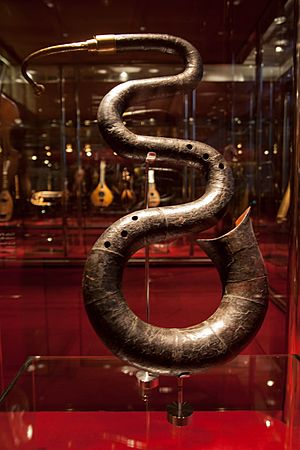Serpent (musical instrument) facts for kids
The serpent is a very old musical instrument. It makes a deep, low sound. It got its name because it's shaped like a winding snake or "serpent." Even though it's made of wood, it has a mouthpiece like a trumpet. Because of this, it's actually part of the brass instrument family!
Contents
What is the Serpent?
The serpent is a unique wind instrument. It has a long, curvy body that looks a bit like the letter 'S'. Most serpents are made from wood, often carved into two halves and then glued together. They are covered in leather to make them airtight.
Even though it's made of wood, the serpent is played like a brass instrument. Players buzz their lips into a cup-shaped mouthpiece, just like a trumpet or tuba player. This buzzing makes the air inside the serpent vibrate and create sound.
How the Serpent Sounds
The serpent can play a wide range of notes. It can go from very low notes, even below the bass clef, up to notes around middle C. Its sound is often described as rich and mellow. It can blend well with other instruments, especially voices.
History of the Serpent
The serpent was probably invented in the late 1500s. A Frenchman named Edme Guillaume is often given credit for creating it. It was first used to support singing in churches, helping to provide a deep bass sound.
Over time, the serpent became popular in military bands and orchestras. It was used for about 200 years. However, playing the serpent was quite tricky! It was hard to play it perfectly in tune because it didn't have valves like modern brass instruments.
The Serpent's Family Tree
In the 1800s, new instruments were invented that were easier to play. The ophicleide was one of these. It was a brass instrument that looked a bit like a bassoon but had keys. The ophicleide took the serpent's place in many orchestras.
Later, instruments like the euphonium and tuba became popular. These instruments have valves, which make them much easier to play in tune and with more agility. Because of these newer, more modern instruments, the serpent was used less and less.
However, the serpent made a small comeback in the late 1800s and 1900s. Today, you can still hear its unique sound in some older musical pieces. For example, it's featured in Berlioz's famous piece, Symphonie Fantastique.
Images for kids
See also
 In Spanish: Serpentón para niños
In Spanish: Serpentón para niños



